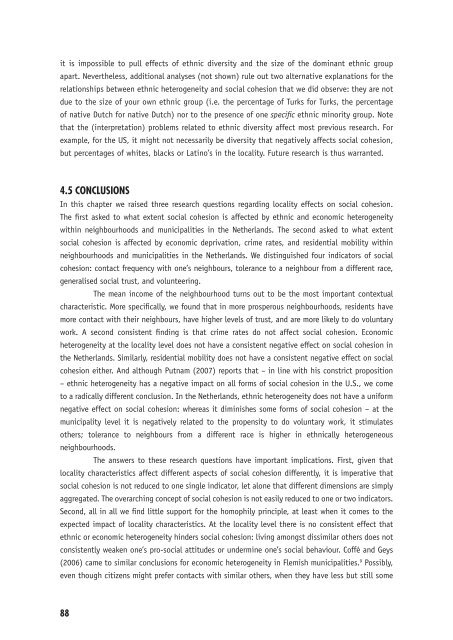Ethnic Hostility among Ethnic Majority and Minority Groups
Ethnic Hostility among Ethnic Majority and Minority Groups
Ethnic Hostility among Ethnic Majority and Minority Groups
You also want an ePaper? Increase the reach of your titles
YUMPU automatically turns print PDFs into web optimized ePapers that Google loves.
it is impossible to pull effects of ethnic diversity <strong>and</strong> the size of the dominant ethnic group<br />
apart. Nevertheless, additional analyses (not shown) rule out two alternative explanations for the<br />
relationships between ethnic heterogeneity <strong>and</strong> social cohesion that we did observe: they are not<br />
due to the size of your own ethnic group (i.e. the percentage of Turks for Turks, the percentage<br />
of native Dutch for native Dutch) nor to the presence of one specifi c ethnic minority group. Note<br />
that the (interpretation) problems related to ethnic diversity affect most previous research. For<br />
example, for the US, it might not necessarily be diversity that negatively affects social cohesion,<br />
but percentages of whites, blacks or Latino’s in the locality. Future research is thus warranted.<br />
4.5 CONCLUSIONS<br />
In this chapter we raised three research questions regarding locality effects on social cohesion.<br />
The fi rst asked to what extent social cohesion is affected by ethnic <strong>and</strong> economic heterogeneity<br />
within neighbourhoods <strong>and</strong> municipalities in the Netherl<strong>and</strong>s. The second asked to what extent<br />
social cohesion is affected by economic deprivation, crime rates, <strong>and</strong> residential mobility within<br />
neighbourhoods <strong>and</strong> municipalities in the Netherl<strong>and</strong>s. We distinguished four indicators of social<br />
cohesion: contact frequency with one’s neighbours, tolerance to a neighbour from a different race,<br />
generalised social trust, <strong>and</strong> volunteering.<br />
The mean income of the neighbourhood turns out to be the most important contextual<br />
characteristic. More specifi cally, we found that in more prosperous neighbourhoods, residents have<br />
more contact with their neighbours, have higher levels of trust, <strong>and</strong> are more likely to do voluntary<br />
work. A second consistent fi nding is that crime rates do not affect social cohesion. Economic<br />
heterogeneity at the locality level does not have a consistent negative effect on social cohesion in<br />
the Netherl<strong>and</strong>s. Similarly, residential mobility does not have a consistent negative effect on social<br />
cohesion either. And although Putnam (2007) reports that – in line with his constrict proposition<br />
– ethnic heterogeneity has a negative impact on all forms of social cohesion in the U.S., we come<br />
to a radically different conclusion. In the Netherl<strong>and</strong>s, ethnic heterogeneity does not have a uniform<br />
negative effect on social cohesion: whereas it diminishes some forms of social cohesion – at the<br />
municipality level it is negatively related to the propensity to do voluntary work, it stimulates<br />
others; tolerance to neighbours from a different race is higher in ethnically heterogeneous<br />
neighbourhoods.<br />
The answers to these research questions have important implications. First, given that<br />
locality characteristics affect different aspects of social cohesion differently, it is imperative that<br />
social cohesion is not reduced to one single indicator, let alone that different dimensions are simply<br />
aggregated. The overarching concept of social cohesion is not easily reduced to one or two indicators.<br />
Second, all in all we fi nd little support for the homophily principle, at least when it comes to the<br />
expected impact of locality characteristics. At the locality level there is no consistent effect that<br />
ethnic or economic heterogeneity hinders social cohesion: living <strong>among</strong>st dissimilar others does not<br />
consistently weaken one’s pro-social attitudes or undermine one’s social behaviour. Coffé <strong>and</strong> Geys<br />
(2006) came to similar conclusions for economic heterogeneity in Flemish municipalities. 9 Possibly,<br />
even though citizens might prefer contacts with similar others, when they have less but still some<br />
88












